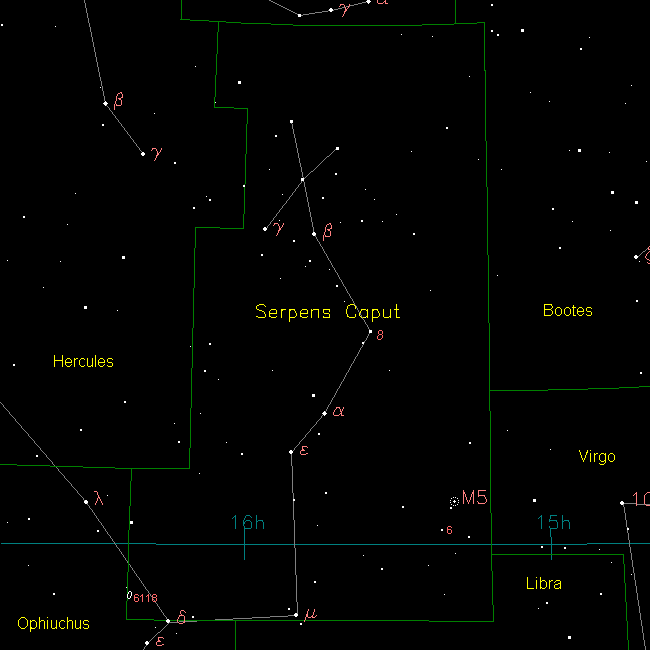[/caption]
The constellation of Serpens is unique – being the only one to be divided into two parts. Serpens Caput represents the western half. Serpens was one of the 48 constellations listed by the 1st century astronomer Ptolemy and it remains one of the 88 modern constellations. The entire constellation spans 637 square degrees of sky and contains 9 main stars within its asterism and 57 Bayer Flamsteed designated stars within its confines. Serpens Caput is bordered by the constellations of Hercules, Corona Borealis, Virgo, Libra, Bootes and separated from its counterpart by Ophiuchus. Serpens Caput can be seen by all observers located at latitudes between +80° and ?80° and is best seen at culmination during the month of July.
In mythology, Serpens represents a huge snake held by the constellation Ophiuchus. It can either be referred to as simply “Serpens” or by its western half (Caput – the “Snake’s Head”) or its eastern half (Cauda – the “Snake’s Tail”). Ophiuchus was believed to have been the son of Apollo and a healer. According to legend, the snake is also meant to represent healing as it sheds its skin in rebirth.
Let’s begin our binocular tour of Serpen Caput with its brightest star – Alpha Serpentis – the “a” symbol on our map. Alpha Serpentis goes by the proper name Unukalhai, meaning loosely the “heart of the serpent”. Alpha Serpentis is approximately 73.2 light years from Earth and it is a great binary star for a small telescope. The primary, Alpha Serpentis A is an orange K-type giant star about 15 times larger than our Sun and its 11th magnitude B star is about 58 arcseconds from the primary. But don’t stop there! If skies are steady, power up and keep looking for the 13th magnitude C star located 2.3 arcminutes from A.
Now, aim your telescope towards Theta – the “8” symbol on our chart. Theta Serpentis is located 132 light years from our solar system and goes by the name of Alya, which means “fat tail”. Guess what? It’s also a great multiple star system! Both Theta-1 Serpentis and Theta-2 Serpentis are white A-type main sequence dwarf stars, very close in magnitude and separated by 22 arcseconds, but Theta Serpentis C is a yellow G-type star that is widely separated from this par by about 7 arc minutes.
For binoculars and all telescopes, let’s take a look a Messier 5 (RA 15 : 18.6 Dec +02 : 05). At nearly unaided eye visible, you’ll like this one! This fifth brightest globular cluster in the sky is considered one of the most ancient at 13 billion years old. Located further away from the dusty galactic center, resolution explodes as we move up in aperture. Easily seen as a round ball of unresolved stars in binoculars, small scopes begin to pick up individual stellar points at higher magnifications. Careful attention shows that M5 is not perfectly round. Its brightest 11th and 12th magnitude stars actually are randomly distributed but seem to array themselves in great arcs.
For a big telescope challenge, try NGC 6118 (RA 16 : 21.8 Dec -02 : 17). It is a very low surface brightness, 13th magnitude spiral galaxy, and although its fairly large, it’s pretty hard to see in small telescopes. This quality has given rise to the nickname the “Blinking Galaxy”, since it only seems to appear during averted vision – only to disappear if the angle isn’t right. About 80 million light-years away, NGC 6118 is a grand-design spiral seen at an angle, with a very small central bar and tightly wound spiral arms. Thank to imagining by the VLA, we know more about this galaxy than ever. In 2004 a supernova event was caught near the galaxy’s center – believed to be the collision of two binary stars!
Sources:
SEDS
Chandra Observatory
Wikipedia
Chart Courtesy of Your Sky.

